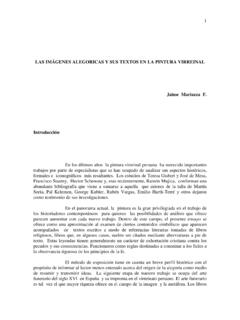Transcription of Tracing the Bear Myth in Northeast Asia - Jonathan …
1 1 JUHA JANHUNENTTTTTRACINGRACINGRACINGRACINGRAC ING THETHETHETHETHE B B B B BEAREAREAREAREAR M M M M MYTHYTHYTHYTHYTH INININININ N N N N NORTHEASTORTHEASTORTHEASTORTHEASTORTHEAS T A A A A ASIASIASIASIASIA11111 JUHA JANHUNENAll over the northern boreal zone of the globe, the bear is widely respectedas the Lord of the Animals, which in some important respects differs from allother wild beasts. The reasons behind the special position of the bear are mul-tiple. Most importantly, the bear has some unique and well-known human-likecharacteristics, including its size, skeletal structure, footprint, ability to stand ina bipedal position, dietary habits, and its annual life cycle, involving hiberna-tion in a specially built den.
2 Although other mammals possess some of thesefeatures, their most perfect combination is materialized in the bear . Not sur-prisingly, human societies in the boreal zone apparently very early developedthe idea that the bear is actually a human, clad in circumstance supporting the special status of the bear is its rela-tively rare but not exceedingly rare occurrence. Although potentially dan-gerous to humans, the bear is traditionally not regarded as a harmful beast, butrather, as a competing hunter, who, if let alone, will not spoil the human hunt-er s chances. The inherent human sympathy towards the bear has not beensubstantially diminished even by the introduction of secondary activities suchas cattle or reindeer breeding, for the harm done by the bear to the herds isgenerally negligible in comparison with that caused by real enemies such as thewolf and the wolverine.
3 The only large carnivore comparable in its habits to thebear is the tiger, and indeed, in those regions where the tiger occurs it is reveredon a par with the Nevertheless, the conceptual framework connected1 This paper was completed during the author s stay at the Slavic Research Center of Hok-kaido University, Sapporo. The author acknowledges the kind help received from the staffat the Center, as well as at the specialized libraries of Hoppou Shiryoushitsu and HoppouBunkaron. Special thanks for both valuable scholarly advice and practical help are due toKoichi For a general introduction to the role of the bear in the mythology of the boreal peoples,see: Carl-Martin Edsman, Bears, in Mircea Eliade, ed.
4 , The Encyclopedia of Religion 2 (NewYork: Macmillan, 1987), pp. 86-89; Hans-Joachim Paproth, Studien ber das B B renjagdriten und B renfeste bei den tungusischen V lkern (Uppsala: Skrifter utgivna avReligionshistoriska institutionen i Uppsala, 1976). The species most typically representingthe bear amongst the boreal peoples is the Eurasian brown bear (Ursus arctos), but otherspecies, notably the North American grizzly (U. horribilis), the Himalayan black bear ( ), and the polar bear (U. maritimus), are known to have been connected with simi-lar mythological As a possible linguistic reflex of the equipollent relation between the bear and the tiger, theKorean names of the two animals may be cited: gom bear vs.
5 Beom tiger, apparently to beArticles2 ACTA SLAVICA IAPONICA with the bear is both geographically wider and structurally more elaborate thanthat connected with the to their relatively small and sparse populations, bears have apparent-ly never been hunted as a primary source of subsistence. It is true that certainparts of the bear , notably the skin and the meat, have an inherent utilitarianvalue, while certain other parts, including the paws, claws, teeth, and gallblad-der are considered useful because of the magic properties attributed to such products also have an exchange value outside of the boreal zone, akilled bear is, even today, a source of income to the hunter and his so, the ultimate reasons behind bear hunting must be sought reason is that the bear offers a challenge to the hunter, allowing him toprove his skill.
6 However, of much greater importance is the mythological di-mension of the bear CULTThe mythological role of the bear is manifested in the complexity of beliefsand practices known as the Circumpolar bear Cult which has been occasionallytraced back to the Palaeolithic hunting societies of the latest glacial Insegmented as and , respectively. It is probably not irrelevant in this context thatKorea, with the adjacent parts of Maritime Manchuria, is a region where a relatively size-able human population has since ancient times been in contact with both the bear and thetiger. The fact that the Korean word for bear has a cognate in Japanese ( ) does notinvalidate the proposed segmentation. Since, however, the Japanese cognate may have aninternal etymology (connected with black ), it is possible that both words are actuallyJaponic borrowings in Shirokogoroff discusses the relationship between man, bear , and tiger, with special refer-ence to the Tungus (Ewenki).
7 According to him, the Tungus think that the tiger and the bearhave a similar right to hunting territories of their own as the Tungus hunter has. As long asthe hunter does not interfere with the territorial interests of the tiger and the bear , theseanimals will not harm him. Interestingly, and somewhat unexpectedly, Shirokogoroff notesthat the Tungus generally consider the tiger more intelligent than the bear , although thebear would superficially appear to have more human-like characteristics than the Shirokogoroff, Psychomental Complex of the Tungus (London: Kegan Paul, Trench, Trub-ner & Co., 1935), pp. On the magic effect of bear paws according to the beliefs of the Manchurian Tungus andManchu, see Shirokogoroff, Psychomental Complex, p.
8 179. Shirokogoroff also reports thatthe Tungus use bear hair as medicine. The gallbladder of the bear is well-known for its medical value all over the boreal zone and beyond, especially in China. Ibid., p. The existence of a bear mythology in Palaeolithic Europe was first seriously proposed byKarl J. Narr, as also discussed by Eliade. Karl J. Narr, B renzeremoniell und Schamanis-mus in der lteren Steinzeit Europas, Saeculum 10/3 (1959), pp. 233-272; Mircea Eliade,Shamanism: Archaic Techniques of Ecstasy, Bollingen Series LXXVI (Princeton: Princeton Uni-versity Press, 1964), pp. 503-504. Subsequent research has questioned the archaeologicaland palaeontological evidence, but, basically, the proposal is sound, although it is, unfortu-nately, impossible to establish what the exact mythological role of the bear , as compared3 JUHA JANHUNENthe bear Cult, the bear is elevated to the status of a supernatural being which,when treated properly, will grant success to the human community.
9 The BearCult may be understood as a conceptual complex aimed at controlling the bear ,and, through the bear , the resources of wild game in the boreal is congruent with the bear s status as the Lord of the Animals, for thebear is thought to have the ability to send not only other bears, but also otherspecies of game to the of the bear Cult include various kinds of taboos connectedwith the bear . Some of the taboos are linguistic, requiring the use of a specialstyle or lexicon when speaking of or to a The underlying reason for this isthat the bear is thought to understand human Other taboos regulatethe methods of killing and skinning a bear , as well as the preparing and eatingof bear meat. There are also taboos pertaining only to certain members or sec-tions of the community, especially to women.
10 Individual taboos concern thosewho have had special bear -related experiences, such as encounters or only instances when the taboos are not observed is when treating a mad bear , which without obvious reason has attacked and hurt members of the other Pleistocene large mammals, may have been. The idea of Palaeolithic roots of theEuropean bear Cult is also supported by Walter (oral communication). Philippe Walter, Le crane de l ours Relique, idole, masque, Lecture and handout presented at HokkaidoUniversity / Hokkaido Minzoku Gakkai, Sapporo, on 25 September, The name of the bear itself is particularly liable to undergo frequent alternations and inno-vations, as noted by Shirokogoroff and Vasilevich for the Ewenki.

